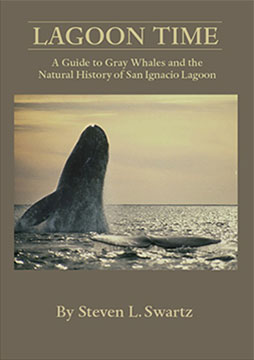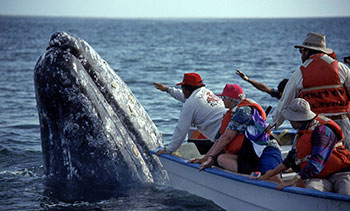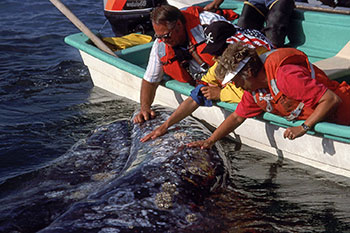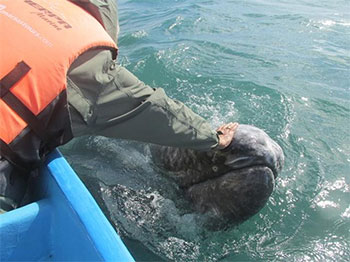 |  |

Along with Laguna Ojo de Liebre (Scammon’s Lagoon) to the north, and Bahia Magdalena to the south, Laguna San Ignacio is one of the three major California gray whale calving lagoons along the Pacific coast of Baja. Anyone even contemplating visiting this famous body of water–a UNESCO World Heritage Site–especially when gray whales are present will likely read Lagoon Time with considerable interest and profit.
The 200-page book is endowed with over 250 color photographs, as well as maps, graphs, and grayscale illustrations. It might be seen as an expanded and updated version of a June 1987 National Geographic article by Steven Swartz and Mary Lou Jones: “Gray Whales at Play in Baja’s San Ignacio Lagoon.”
Lagoon Time tells how, during six whale seasons (1977-1982) two young graduate students, author Steven Swartz and “lifelong sweetheart” Mary Lou Jones, camped on the shores of Laguna San Ignacio to “document the gray whales that utilized the lagoon during the winter months… to breed, give birth, and care for their newborn calves.”
Lagoon Time provides background about what led to their study, and how their research was conducted. The book also contains a broad and readable summary of the lagoon’s natural history, and human history, especially as it relates to the whales. And in a “Guide” section, there are convenient, well-illustrated chapters on “common” gray whale behaviors, winter birds, mammals, and desert and lagoon plants.
Among the reasons given for their research project, Steven Swartz confides there were “concerns that well-meaning whale-watchers from the United States might be disturbing the whales in their breeding lagoons.”

Most of the whale-watching there at the time took place on week-long trips from San Diego aboard chartered sport fishing boats. Inside the lagoon, skiffs were lowered to permit close-up observation and interaction with the whales.
Steven Swartz and Mary Lou Jones first headed down in 1977 in a packed VW bus. The previous year San Diego newspapers had reported that gray whales had begun approaching boats in Laguna San Ignacio, and on occasion whale-watchers were able to “pet” them. They wondered if they would encounter these “friendly” whales.
Using an inflatable boat and an 18-foot observation “tower” set up on the south shore of the 60-square-mile lagoon, they logged the movement of the whales, and assembled a catalog of photographs detailing more than 500 different individuals.
Their sightings confirmed that whale counts peaked in mid-February. And by March nearly all the whales within the lagoon were mothers and calves. Initially the mother-calf pairs tended to occupy the shallower middle and upper lagoon areas, but with the departure of the courting animals they moved toward the channel nearest the open ocean.

Among the topics covered, the book summarizes the history of whaling in the breeding lagoons, especially the life and writings of Charles Scammon, the first skipper to gain access to Ojo de Liebre and Laguna San Ignacio. Others followed, and began a slaughter that in little more than a generation took the gray whale to the brink of extinction.
The whalers paid a price! After Scammon’s boat had entered Ojo de Liebre: “The first whale they pursued busted their whaleboat, severely injuring several [of] the crew. Another whale turned the first rescue boat into kindling.” The whalers called their dangerous prey “devilfish.”
Ironically, the feared “devilfish” of the nineteenth-century whalers has become the “friendly” of today. The mothers that once smashed boats and bones to defend their young are now lifting and escorting their babies to almost identical boats to be admired and caressed by the descendants of their tormentors!
By the time of the publication of the 1987 National Geographic article, the gray whale population probably reached 26,000 individuals, back to pre-whaling estimates. The Eastern Pacific gray whale was taken off the Endangered Species List in 1994.

Then, according to Swartz, “something unexpected happened; beginning in 1998 gray whales began to strand in unusually large numbers throughout their entire range from Alaska to Mexico.” The stranded whales appeared to be suffering from nutritional stress. A 2000 census suggested that the population had been reduced to 16,000 individuals.
The whale die-off was almost certainly associated with the 1997-1998 El Niño, which was the biggest in recorded history. Warm water blocked the normal upwelling of cold, nutrient-rich coastal water, causing a vast reduction in the amount of plankton, with drastic consequences for marine life.
Lagoon Time brings us up to date with the latest findings, even beyond the lagoon. In 2010 a gray whale was spotted in the Mediterranean. A different individual turned up off the coast of Namibia in 2013–the first record of a gray whale ever south of the equator. “The best guess as to what facilitated the surprise appearance of gray whales in the Atlantic for the first time in more than 200 years was an anomalously low Arctic summer sea ice extent in 2007 and again in 2012.”
The book contains an interesting discussion about the importance of sustainable ecotourism and the struggle to protect the lagoon’s delicate environment, culminating in the well-publicized “salt wars” which resulted in the abandonment of a plan for a massive industrial-scale, solar evaporation salt extraction facility for the lagoon.

Swartz admits the case against the salt project was not entirely scientific. It was hard to rail against the proposed salt works when the company involved, Exportadora de Sal, SA, (ESSA) was operating a similar large and successful solar salt farming facility in Scammon’s Lagoon, creating hundreds of jobs, with no apparent injury to the whales or other species in that lagoon. Indeed, the gray whale population had grown steadily during the years of the salt company’s operation.
Nevertheless, some environmentalists, and scientists, appalled by the thought of such development in Laguna San Ignacio, were inclined to blame the company for the increasing number of dead whales and other marine species found along the shore. The project was abandoned in 2000.
Like many who have come to treasure Laguna San Ignacio, and the special kind of interaction with whales one experiences there, Steven Swartz is as fiercely protective as a mother gray whale: “Something needed to be done to build a body of scientific evidence on which to base a convincing argument in support of maintaining this wilderness area, and to fend off the next and likely inevitable assault by developers.”
A case could be made that it wasn’t science that stopped the proposed salt works, but rather political and commercial pressure brought to bear against the company, which is jointly owned by the Mexican government (51%) and Mitsubishi (49%).
And some readers might be irritated by the instances of sloppy editing throughout the book: dessert for desert, gentile for gentle, and treats for threats! But that would be quibbling.
Steven Swartz’s new book more than lives up to its subtitle–it is a very worthwhile and informative “guide to Gray Whales and the Natural History of San Ignacio Lagoon.”
Book is available on Amazon
About Graham
Graham is the author of four books on Baja California including Nearer My Dog to Thee which describes a four-month sojourn in the Sierra San Pedro Mártir with two adopted street dogs. Details on all Graham’s books can be found on his website: www.grahammackintosh.com